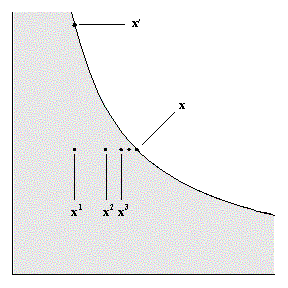|
|
| ||
Representation of Preferences by a Utility Function
A consumer's preferences can be represented by a utility function if they satisfy properties P.1 through P.4, and one additional property called continuity. Continuity is probably the least intuitive property of preferences, yet it is not implausible.
P.5 The "Continuity" Property
Preferences are continuous if the set of all choices that are at least as good as a choice x' and the set of all choices that are no better than x' are both closed sets. In the notation of sets, this is written as {x : x ![]() x'} and {x : x'
x'} and {x : x' ![]() x} are both closed.
x} are both closed.
One definition of a closed set is that any sequence of points in the set that converges, converges to a point of the set. In this context, that means that for a sequence of points {xn} with n = 1, 2, 3, ..., if x ![]() xn for every xn and if xn converges to some consumption point x', then x
xn for every xn and if xn converges to some consumption point x', then x ![]() x'.
x'.
Figure 6 shows an example of this. In the figure, if x ![]() xn for every n, and if xn converges to x', then continuity implies that x
xn for every n, and if xn converges to x', then continuity implies that x ![]() x'.
x'.

Figure 6: Sequence of points xn that converge to x'.
Representation Theorem
If a consumer has a preference relation ![]() that is complete, reflexive, transitive, strongly monotonic, and continuous, then these preferences can be represented by a continuous utility function u(x) such that u(x) > u(x') if and only if x
that is complete, reflexive, transitive, strongly monotonic, and continuous, then these preferences can be represented by a continuous utility function u(x) such that u(x) > u(x') if and only if x ![]() x'.
x'.
Proof : Let e = (1, 1, ..., 1). For each x, define u(x) by u(x) e ![]() x. Then u(x) is a utility function for the preferences
x. Then u(x) is a utility function for the preferences ![]() if
if
1. such a function u(x) exists,
2. the function u(x) is unique, and
3. u(x) > u(x') if and only if x ![]() x'.
x'.
Let B = {a: a e ![]() x}. If x = (x1, x2), let y = (max{x1, x2}, max{x1, x2}). Then strong monotonicity implies that y
x}. If x = (x1, x2), let y = (max{x1, x2}, max{x1, x2}). Then strong monotonicity implies that y ![]() x, so B is not empty. Let W = {a: x
x, so B is not empty. Let W = {a: x ![]() a e}. Then 0 is an element of W, so W is not empty. By completeness, B
a e}. Then 0 is an element of W, so W is not empty. By completeness, B ![]() W = {a : a
W = {a : a ![]() 0}. Both B and W are closed sets, from property P.5 (continuity), so B
0}. Both B and W are closed sets, from property P.5 (continuity), so B ![]() W is not empty. Therefore, there is some a such that a e
W is not empty. Therefore, there is some a such that a e ![]() x. By strong monotonicity, if a' > a, then a' e
x. By strong monotonicity, if a' > a, then a' e ![]() x, and if a' < a, then x
x, and if a' < a, then x ![]() a' e, so a is unique. Let u(x) = a. So u(x) exists and it is unique.
a' e, so a is unique. Let u(x) = a. So u(x) exists and it is unique.
Next, we want to show that u(x) represents the preferences ![]() . Suppose that x and y are two consumption levels and u(x) = ax where a x e
. Suppose that x and y are two consumption levels and u(x) = ax where a x e ![]() x. Let u(y) = a y where a y e
x. Let u(y) = a y where a y e ![]() y. If a x > a y then by monotonicty a x e
y. If a x > a y then by monotonicty a x e ![]() a y e. By transitivity, x
a y e. By transitivity, x ![]() a x e
a x e ![]() a y e
a y e ![]() y. Finally, if x
y. Finally, if x ![]() y, then a x e
y, then a x e ![]() a y e so that a x > a y.
a y e so that a x > a y.
| Copyright 2006 Experimental Economics Center. All rights reserved. | Send us feedback |



